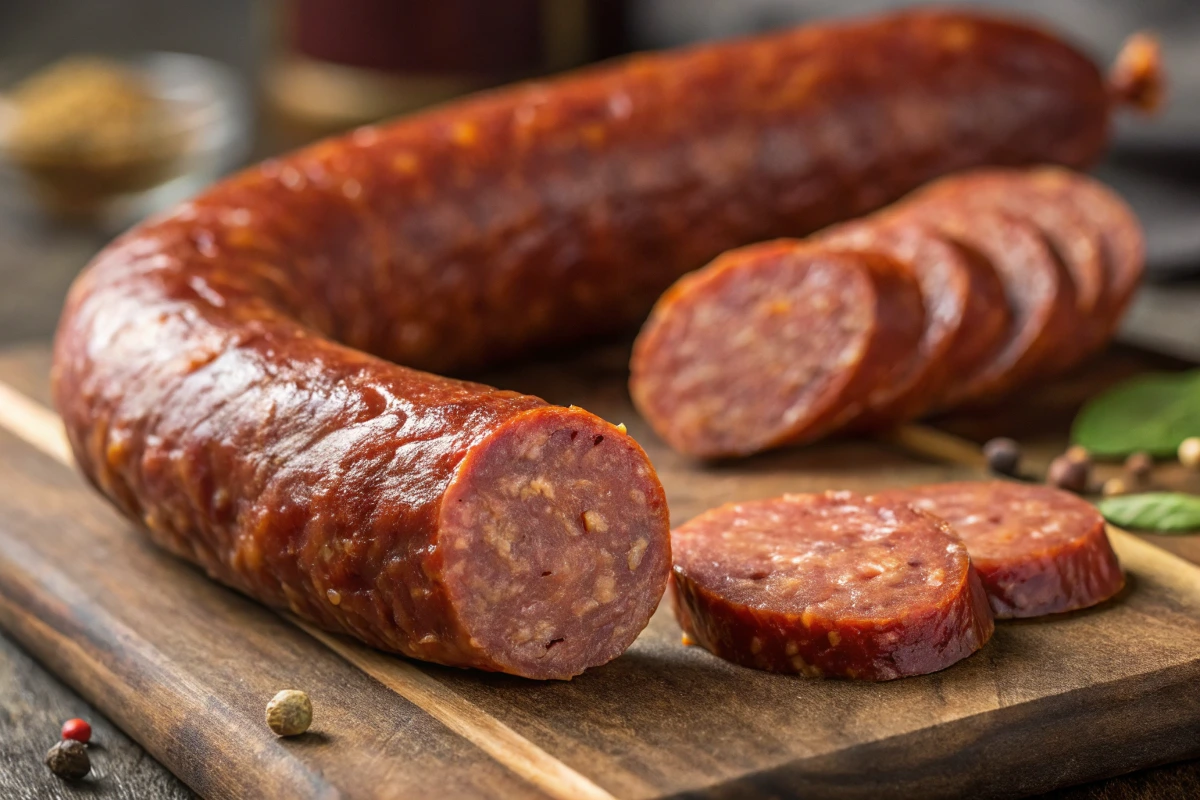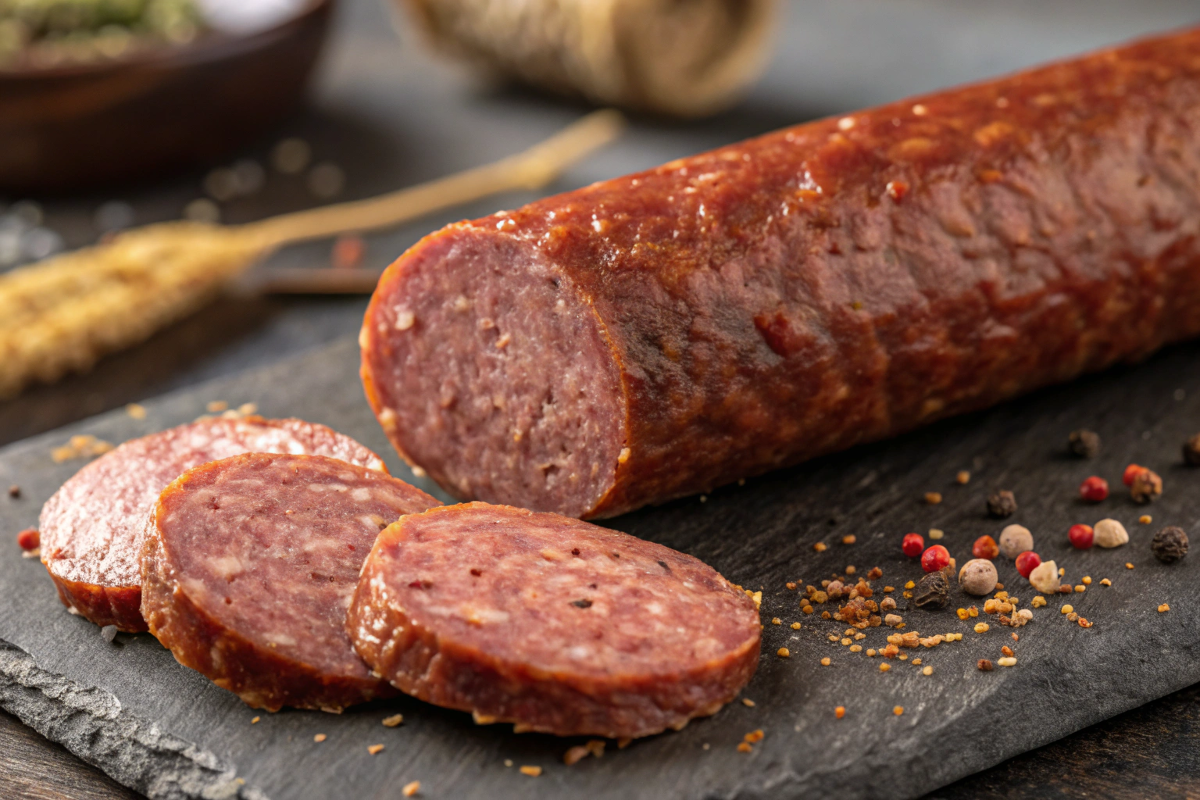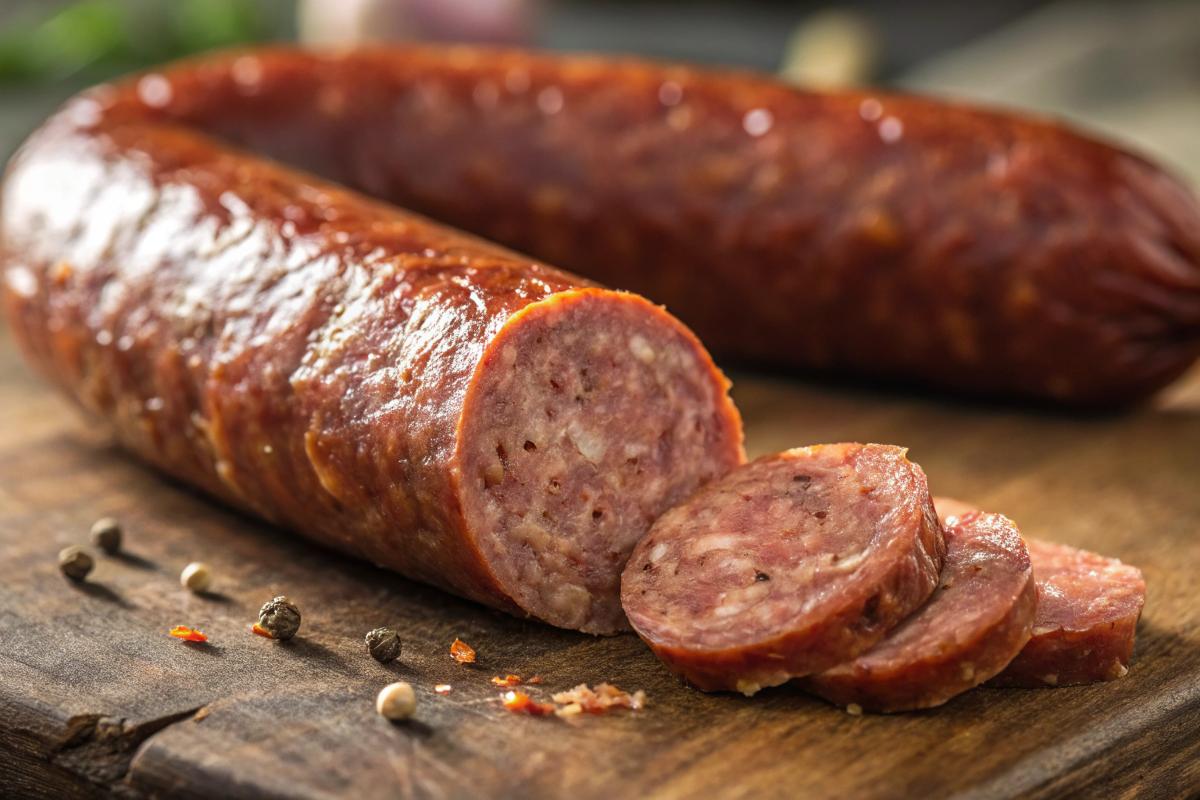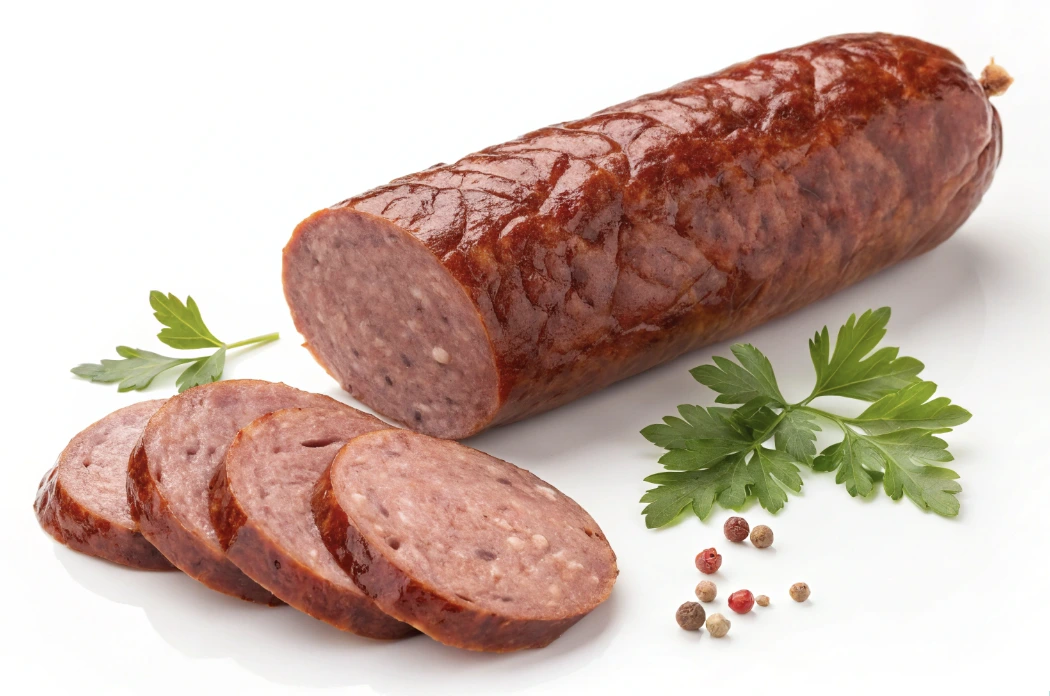Making beef sausage at home offers a rewarding culinary experience that lets you take control of the ingredients, flavor, and quality. By crafting your own, you can ensure every bite is fresh and tailored to your preferences. Whether you’re firing up the grill at a summer barbecue or adding a savory twist to your breakfast spread, homemade beef sausage proves to be both versatile and delicious. Moreover, it gives you the satisfaction of enjoying something uniquely your own while avoiding unnecessary additives.
Why Beef Sausage Is a Crowd Favorite
Beef sausage has earned its place as a staple on many tables because of its rich, hearty flavor that pairs beautifully with a variety of spices and herbs. Unlike store-bought options, homemade versions offer the freedom to experiment with seasoning blends, textures, and cooking styles. For example:
- Customizable Flavor: Add spices like garlic, fennel, or paprika to create unique flavor profiles.
- No Preservatives: Skip artificial additives for a healthier alternative.
- Versatile Cooking: Grill, fry, bake, or simmer to suit any meal or occasion.
This ability to adapt and elevate any dish makes beef sausage a perennial favorite among home cooks and food enthusiasts alike.
Essential Ingredients for Beef Sausage
Creating the perfect beef sausage starts with selecting the right ingredients. Each component plays a vital role in ensuring the sausage is flavorful, moist, and has the desired texture. Here’s a breakdown of the essential ingredients you’ll need:
Selecting the Best Beef Cuts for Sausage
The foundation of any great beef sausage is high-quality beef. Opt for cuts that balance flavor and fat content to achieve the ideal texture. Popular choices include:
- Chuck: Known for its rich flavor and well-distributed fat.
- Brisket: Provides a hearty taste and works well in sausage blends.
- Round: Leaner, making it suitable for lighter sausage recipes.
Ensure your beef is fresh and trimmed appropriately to avoid excess sinew
Spices and Seasonings to Perfect Your Beef Sausage
Seasonings are what give beef sausage its unique flavor profile. You can experiment, but these are the staples:
- Garlic Powder and Onion Powder: Add depth and a savory base.
- Smoked Paprika: Enhances the sausage with a mild smokiness.
- Black Pepper: Offers a touch of heat and complexity.
- Salt: Essential for flavor balance; adjust to suit your taste.
Feel free to include additional spices like chili flakes, fennel seeds, or fresh herbs for customization.
The Role of Casings in Homemade Beef Sausage
Casings are crucial for shaping your sausage and creating the authentic experience. You can choose between:
- Natural Casings: Made from animal intestines, these provide a traditional texture and are ideal for enthusiasts seeking authenticity.
- Synthetic Casings: Easier to use and store, synthetic options are practical but less traditional.
If you’re new to sausage making, synthetic casings may be a more manageable choice.
Liquid Additions
Moisture is key to preventing your beef sausage from becoming dry. Adding ice water or broth to your mixture helps:
- Bind the spices evenly throughout the meat.
- Maintain a juicy texture during cooking.
Be precise with the amount to avoid over-saturation, which can compromise the consistency.
With these essential ingredients, you’re ready to craft flavorful and satisfying beef sausage at home.

Tools You Need for Beef Sausage Preparation
Equipping your kitchen with the right tools is essential for a seamless beef sausage making experience. From grinding the meat to stuffing the casings, having the proper equipment ensures efficiency and precision. Here’s what you’ll need:
Essential Equipment for Making Beef Sausage
To create high-quality beef sausage, the following tools are indispensable:
- Meat Grinder: A meat grinder is critical for achieving the perfect sausage texture. Choose a model that allows you to control the coarseness of the grind.
- Sausage Stuffer: This tool ensures even and efficient filling of casings, reducing the risk of air pockets. Manual or electric options are available based on your needs.
- Large Mixing Bowls: Essential for combining the ground beef with seasonings, ensuring an even distribution of flavors.
Optional Tools for Better Beef Sausage Results
While not mandatory, these tools can make the process easier and more precise:
- Kitchen Scale: Helps measure ingredients accurately, especially when working with recipes that require specific spice-to-meat ratios.
- Thermometer: Ensures the sausages cook to a safe internal temperature, typically 160°F (71°C) for beef.
- Parchment Paper: Ideal for shaping casing-free sausages or for prepping sausages for freezing.
Having these tools at your disposal not only simplifies the process but also allows you to achieve professional-quality results when making your own beef sausage.
Optional Tools
While not mandatory, these tools can make the process easier and more precise:
- Kitchen Scale: Helps measure ingredients accurately, especially when working with recipes that require specific spice-to-meat ratios.
- Thermometer: Ensures the sausages cook to a safe internal temperature, typically 160°F (71°C) for beef.
- Parchment Paper: Ideal for shaping casing-free sausages or for prepping sausages for freezing.
Having these tools at your disposal not only simplifies the process but also allows you to achieve professional-quality results when making your own beef sausage.
Mixing and Spicing
Perfectly seasoning and blending your beef sausage mixture is crucial to achieving a flavorful and consistent result. By following these steps, you’ll ensure that every bite delivers a balanced taste.
Getting the Blend Right
- Combine Thoroughly:
Mix the ground beef, spices, and liquids until they are evenly distributed. This step ensures that each bite of the sausage has a consistent flavor. Use your hands or a stand mixer with a paddle attachment for thorough mixing. - Test the Mixture:
Before moving on to stuffing, cook a small portion of the mixture in a skillet. Taste it to check the flavor profile. If needed, adjust the seasoning by adding more salt, spices, or herbs. This step saves you from ending up with under-seasoned sausages. - Pro Tip:
Always use cold ingredients, including ice water or chilled broth, during the mixing process. Cold temperatures help maintain a firm texture, preventing the fat from melting prematurely, which is key to the sausage’s structure and juiciness.
By taking your time with this step, you can create beef sausages that are evenly seasoned, juicy, and packed with flavor

Stuffing and Cooking Beef Sausage
Properly stuffing the casings is a key step in making beef sausage. This process ensures that your sausages are uniform, well-shaped, and ready for cooking or storage. Follow these detailed steps for the best results.
How to Stuff Beef Sausage Casings Correctly
- Soften the Casings:
If you’re using natural casings, soak them in warm water for about 30 minutes. This softens the casings, making them easier to handle and stretch over the stuffer nozzle. - Attach the Casing:
Secure one end of the casing onto the sausage stuffer nozzle, ensuring there’s enough slack to start filling smoothly. Tie a knot at the other end to prevent the filling from spilling out. - Fill Casings Consistently:
Operate the stuffer with even pressure to ensure the mixture fills the casing uniformly. Avoid overfilling to prevent the casing from splitting. - Twist Uniform Links:
After filling, twist the sausage at regular intervals to create uniform links. Alternate the twisting direction (e.g., clockwise, then counterclockwise) to keep the links secure.
Troubleshooting Tips
- Air Pockets: Use a pin to gently prick any visible air bubbles, releasing trapped air without damaging the casing.
- Casing Splits: Avoid overstuffing or applying too much pressure, which can cause the casing to burst during cooking.
By mastering these techniques, you can achieve professional-quality beef sausages that are evenly shaped and ready to impress at your next meal.
Cooking Techniques
Cooking beef sausage properly is as important as crafting the sausage itself. The right method not only enhances the flavor but also ensures a juicy, well-cooked result. Here are the most popular cooking techniques and tips to help you get the best out of your sausages.
Popular Methods
- Grilling:
Grilling is ideal for achieving smoky, charred flavors that enhance the natural richness of beef sausage. Preheat the grill to medium heat, and cook the sausages evenly, turning occasionally. This method is perfect for barbecues or outdoor gatherings. - Pan-Frying:
For quick and convenient preparation, pan-frying is an excellent choice. Heat a skillet over medium heat, add a small amount of oil, and cook the sausages until golden brown. This method works well for breakfast sausages or when you’re short on time. - Smoking:
Smoking is a slower method but infuses the sausages with a deep, robust flavor. Use a smoker or a grill with indirect heat and wood chips. This technique is perfect for hearty meals or when you want a unique, savory twist.
Cooking Tip
Always ensure your beef sausage reaches an internal temperature of 160°F (71°C) to guarantee safe consumption. Use a meat thermometer to check the temperature at the thickest part of the sausage. This step is crucial for food safety while maintaining a juicy texture.
By choosing the right method, you can enjoy beef sausage in a variety of delicious ways, tailored to your meal and flavor preferences.

Storing Sausages
Proper storage of beef sausage is essential to maintain its freshness, flavor, and safety. Whether you’ve prepared a batch for immediate use or want to keep some for later, follow these storage tips to ensure the best results.
Refrigeration
To store uncooked sausages in the refrigerator:
- Place them in an airtight container or tightly wrap them in plastic wrap to prevent exposure to air and contamination.
- Store them in the coldest part of the fridge, typically the back of a lower shelf.
- Use refrigerated sausages within three days to ensure freshness and quality.
Freezing
For longer storage, freezing is an excellent option. Follow these steps:
- Wrap sausages individually in freezer-safe packaging, such as heavy-duty aluminum foil, freezer paper, or airtight freezer bags, to avoid freezer burn.
- Label the package with the date for easy tracking.
- Store sausages in the freezer at 0°F (-18°C) or below, where they can last for up to three months without significant loss of quality.
Pro Tip
When ready to use frozen sausages, thaw them in the refrigerator overnight. Avoid defrosting at room temperature, as this can encourage bacterial growth.
By adhering to these storage guidelines, you can preserve the flavor and safety of your beef sausage until you’re ready to enjoy it.
Flavor Variations
One of the best aspects of making your own beef sausage is the ability to customize flavors to suit your preferences. By experimenting with different ingredients, you can create unique flavor profiles that elevate your sausages. Here are some popular variations:
Herb-Infused Beef Sausage
For a fresh, earthy taste, incorporate herbs into your sausage mixture. Try using:
- Rosemary: Adds a fragrant and slightly piney flavor.
- Thyme: Offers subtle citrus and floral notes.
- Parsley: Provides a bright, fresh finish to balance the richness of the beef.
Chop the herbs finely and mix them evenly into the meat. This variation pairs beautifully with grilled vegetables or a fresh salad.
Spicy Beef Sausage
If you enjoy a kick of heat, turn up the spice in your beef sausage with these ingredients:
- Cayenne Pepper: Adds bold, lingering heat.
- Red Chili Flakes: Provide a balanced spice and texture.
- Hot Sauce: Enhances both heat and tanginess.
This version is perfect for those who love bold, fiery flavors, making it an excellent choice for tacos or spicy breakfast dishes.
Garlic and Onion Blend
For a savory, rich sausage, blend in aromatic ingredients like:
- Roasted Garlic: Offers a mellow, slightly sweet garlic flavor.
- Caramelized Onions: Add sweetness and depth to balance the beef’s natural flavor.
Mix these ingredients thoroughly into the sausage for a taste that works well in pasta dishes, pizzas, or as a standalone star.
By exploring these flavor variations, you can transform your homemade beef sausage into a culinary delight tailored to your taste preferences.

Common Mistakes to Avoid
Making beef sausage at home can be a rewarding experience, but there are common pitfalls that can impact the flavor, texture, and overall quality of your sausages. Here’s how to avoid them:
Over-Stuffing Casings
One frequent mistake is over-stuffing the casings, which can lead to splitting during cooking. To prevent this:
- Fill casings evenly and avoid applying excessive pressure when using a sausage stuffer.
- Leave some flexibility in the casing to allow for expansion as the sausage cooks.
This simple adjustment will help you achieve perfectly intact sausages.
Under-Seasoning
Bland sausages often result from not using enough spices or seasoning. Avoid this by:
- Mixing your ingredients thoroughly to ensure the spices are evenly distributed.
- Cooking a small sample of the mixture before stuffing to taste and adjust the seasoning as needed.
This step ensures your beef sausage is packed with flavor.
Skipping Chilling Steps
Keeping the meat cold during preparation is essential for maintaining the sausage’s structure and texture. Warm meat can cause the fat to melt prematurely, resulting in greasy sausages. To avoid this:
- Chill your meat and equipment, such as bowls and the grinder, before starting.
- Refrigerate the sausage mixture after blending and before stuffing if necessary.
By adhering to these tips, you’ll create high-quality, flavorful beef sausages without common mishaps.
Customizing Beef Sausage for Unique Flavors
Customizing your beef sausage allows you to create unique flavors and cater to specific dietary needs. Whether you’re aiming for healthier options or international flair, these tips can help you tailor your sausages to your preferences.
Dietary Adjustments for Healthier Beef Sausage
For those with specific dietary requirements, consider these modifications:
- Lower Sodium: Reduce the amount of salt in your recipe or substitute it with low-sodium seasonings like garlic powder or smoked paprika. This helps create a heart-healthy sausage without compromising flavor.
- Gluten-Free Options: Use gluten-free breadcrumbs or almond flour as a binder in recipes that call for traditional breadcrumbs. This ensures your sausage is safe for those with gluten sensitivities or celiac disease.
International Flavors for Creative Beef Sausage
Take your beef sausage on a global culinary journey by incorporating spices and herbs inspired by international cuisines:
- Moroccan: Add cumin, coriander, cinnamon, and harissa for a bold, spicy flavor profile. These ingredients pair well with roasted vegetables or couscous.
- Italian: Blend fennel seeds, basil, oregano, and a touch of garlic to create a sausage reminiscent of classic Italian dishes. This variation is perfect for pasta or pizza.
FAQs About Beef Sausage
What Are the Best Cuts of Beef for Sausage?
The best cuts of beef for making beef sausage include chuck roast and brisket. These cuts are favored for their well-balanced flavor and fat content, which are crucial for juicy and flavorful sausages.
2. How Can I Avoid Common Beef Sausage Mistakes??
Absolutely! You can easily make casing-free sausages by forming the mixture into patties or rolling it into logs. These alternatives are ideal for quick meals or if you don’t have casings on hand
3. How do I prevent air pockets in the sausage?
To prevent air pockets, gently prick the casing with a pin or needle during stuffing. This step releases trapped air and ensures the sausage fills evenly without compromising the casing.
4. How Long Can Beef Sausage Be Stored?
Homemade sausages can be stored in the refrigerator for up to three days. For longer storage, freeze them in airtight packaging for up to three months to maintain quality and flavor.
5. What’s the ideal fat-to-lean ratio?
An 80/20 fat-to-lean ratio is the recommended mix for beef sausage. This balance ensures the sausage remains juicy while retaining a firm texture during cooking.
6. Can I add cheese to my beef sausage?
Yes! Adding shredded or cubed cheese can enhance the flavor of your sausage. Cheddar and mozzarella are excellent choices, offering a creamy, rich texture that complements the beef.
These answers address common concerns and provide practical tips for making perfect beef sausage.
Conclusion
Making beef sausage at home is a truly enjoyable and rewarding culinary project. By carefully selecting high-quality ingredients, mastering essential techniques, and experimenting with unique flavors, you can craft sausages that surpass the taste and quality of store-bought versions. The versatility of beef sausage—whether grilled, fried, or smoked—ensures it will be a crowd-pleaser for any occasion.
Homemade beef sausage is more than just a dish; it’s an opportunity to showcase your creativity in the kitchen. From bold international flavors to customized dietary adjustments, the possibilities are endless.
So, why not start your sausage-making journey today? Share your creations with family and friends, and inspire them to try their hand at making beef sausage too. It’s a delicious and satisfying way to bring people together over great food.


5 thoughts on “Beef Sausage: How to Make, Customize, and Cook at Home”